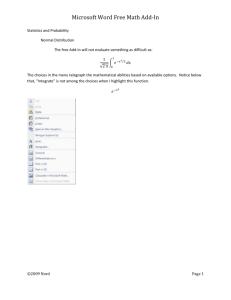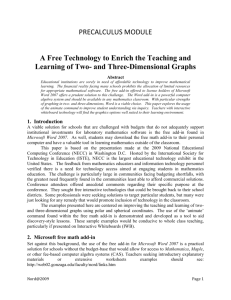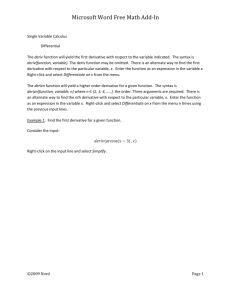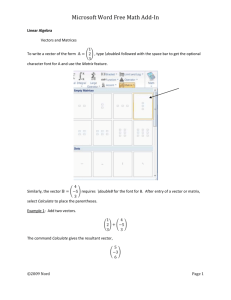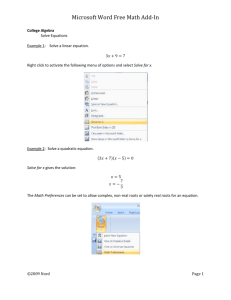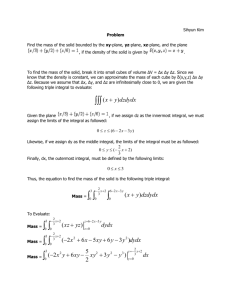Calculus Module
advertisement
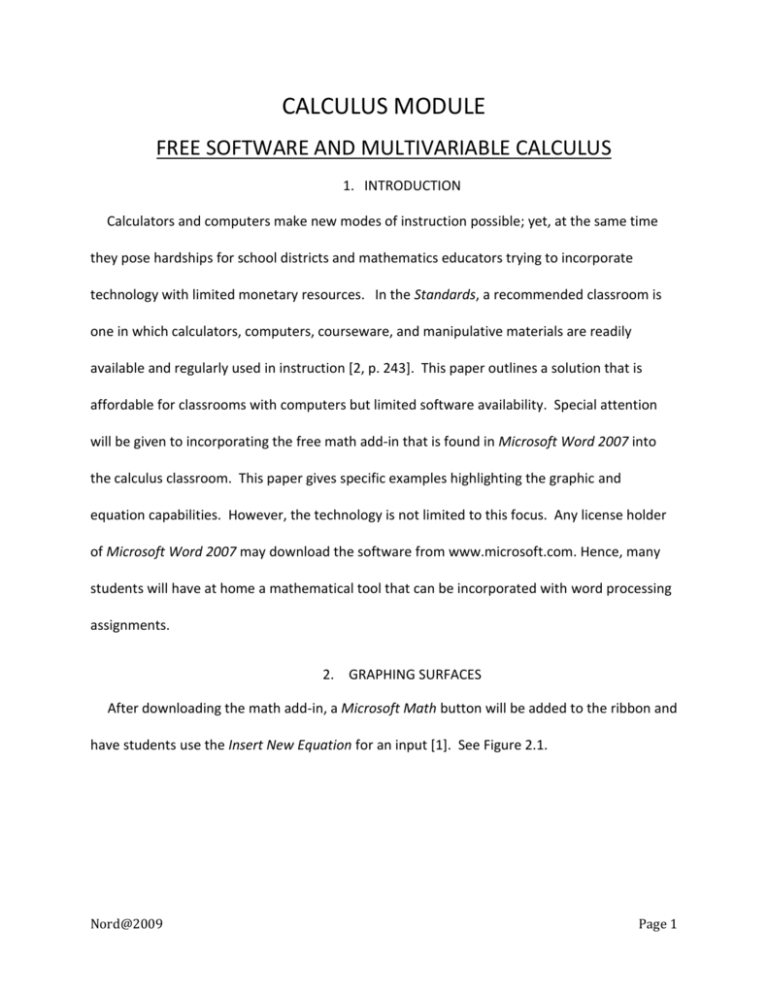
CALCULUS MODULE
FREE SOFTWARE AND MULTIVARIABLE CALCULUS
1. INTRODUCTION
Calculators and computers make new modes of instruction possible; yet, at the same time
they pose hardships for school districts and mathematics educators trying to incorporate
technology with limited monetary resources. In the Standards, a recommended classroom is
one in which calculators, computers, courseware, and manipulative materials are readily
available and regularly used in instruction [2, p. 243]. This paper outlines a solution that is
affordable for classrooms with computers but limited software availability. Special attention
will be given to incorporating the free math add-in that is found in Microsoft Word 2007 into
the calculus classroom. This paper gives specific examples highlighting the graphic and
equation capabilities. However, the technology is not limited to this focus. Any license holder
of Microsoft Word 2007 may download the software from www.microsoft.com. Hence, many
students will have at home a mathematical tool that can be incorporated with word processing
assignments.
2. GRAPHING SURFACES
After downloading the math add-in, a Microsoft Math button will be added to the ribbon and
have students use the Insert New Equation for an input [1]. See Figure 2.1.
Nord@2009
Page 1
Figure 2.1
The graph of the elliptic paraboloid z = 2𝑥 2 + 𝑦 2 and its tangent plane 𝑧 = 4𝑥 + 2𝑦 − 3 when
x = 1 and y = 1, can be graphed simultaneously [7, p. 960]. Students should insert each
separately and then highlight jointly both equations by dragging using the left button on the
mouse. The image shown is seen in Figure 2.2
Figure 2.2 Highlight.
Have students right click within the shaded region. The menu seen in Figure 2.3 will appear.
2𝑥 2 + 𝑦 2
4𝑥 + 2𝑦 − 3
Nord@2009
Page 2
Figure 2.3 Plot in 3D.
Alternatively, the Plot in 3D option appears after clicking on the down arrow at Math as shown
in Figure 2.4. A pull down menu, as shown in Figure 2.5, will appear. Selecting Plot in 3D and
the Rotate button captures a viewpoint that illustrates the plane is tangent to the curve as seen
in Figure 2.6.
Figure 2.4 Math.
Nord@2009
Page 3
Figure 2.5 Plot in 3D.
Students may recognize that the surface is not defined below the x- y plane and is unbounded
above. The sections parallel to the x-y plane are ellipses, where the sections parallel to the
other coordinate planes are parabolas.
Figure 2.6 The graphs of z = 2 𝑥 2 + 𝑦 2 and z = 4𝑥 + 2𝑦 − 3
Students should consider a quadric surface which is a hyperboloid of one sheet such as,
𝑧 2 + 1 = 𝑥 2 + 𝑦 2 /4 . It can be graphed without the axes and units displayed by using the
Nord@2009
Page 4
icons in the Display menu. Students should be directed to find the trace in the x-y plane is an
ellipse and the traces in the other coordinate planes are hyperbolas as shown in Figure 2.7. The
curve is rotated about the y-axis for a fine visual effect.
Figure 2.7 Hyperboloid of one sheet.
3. CREATING A MOVIE USING TWO SURFACES
The next example will assume students understand the ceiling (or floor) function. A list of
other functions may be found at:
http://web02.gonzaga.edu/faculty/nord/wordusersmanual/builtinfunctions.docx
The command ceiling yields the right most integer for a given input. Similarly, the command
floor yields an integer that is closest to the left of an input. If the input is an integer in either
case, the output will be the original input value. For example, floor 3.22 = 3 and ceiling 3.22 = 4.
Students should discover that the Animate option appears by default in two-dimensions
when using a letter other than x and y with Cartesian coordinates and r with polar coordinates.
Nord@2009
Page 5
For three-dimension, using variables other than x, y and z will produce the Animate option. The
variables, r, s, and t, are used to graph polar three-dimensional surfaces and curves and
typically should not be used as an animation variable. The user is allowed to toggle values for
the variable, such as a, that is defined. See Figure 3.1. Students may opt to play a movie,
where the variable is allowed to increment in time.
The students have the tools now to create a customized movie where the picture oscillates
back-and-forth from two quadric surfaces such as a hyperbolic paraboloid, 𝑧 = 𝑥 2 − 𝑦 2 /4 and
an elliptic paraboloid, 𝑧 = 𝑥 2 + 𝑦 2 /4. The students will need to first define a variable, a, to
animate on. The command ceiling a will always yield an integer. Therefore, (−1)𝑐𝑒𝑖𝑙𝑖𝑛𝑔 𝑎 will
take on only two values, -1 or 1 . After selecting Plot in 3D, have students select the domain for
a. For larger values of a, the oscillation will increase. Let a =16 for example. The input the
students should be able to realize that works is 𝑧 = 𝑥 2 + (−1)𝑐𝑒𝑖𝑙𝑖𝑛𝑔 𝑎 𝑦 2 /4. The two quadric
surfaces that will alternatively appear will be a hyperbolic paraboloid, as shown in Figure 3.2,
and an elliptic paraboloid.
Nord@2009
Page 6
Figure 3.1 Toggle values.
Figure 3.2 Create animation.
4. FURTHER GRAPHING FEATURES
Nord@2009
Page 7
Other features in the free math add-in include the capability to graph points, curves, and
surfaces in two dimensions or three-dimensions using Cartesian, polar, parametric and
cylindrical coordinates. Using Table 4.1, the students can be left to explore the many other
graphing features and find patterns for the behavior of particular types of functions, curves,
and surfaces. The absence, in some cases, of a command is permissible. The pull-down menu
will have options such as Plot in 2D and Plot in 3D added for some examples, depending upon
the input and the omission.
Nord@2009
Page 8
Command
Example
Notation
Requirements
plot
𝑝𝑙𝑜𝑡(3 ∗ 𝑥 2 + 12 ∗ 𝑥)
plot3D
𝑝𝑙𝑜𝑡3𝐷(𝑥 + 𝑦 3 )
plotCylDataSet3D
plotCylParamLine3D
𝜋 3𝜋
𝑝𝑙𝑜𝑡𝐶𝑦𝑙𝐷𝑎𝑡𝑎𝑆𝑒𝑡3𝐷({{1, 2, 𝜋}, {3, , }})
2 2
𝑝𝑙𝑜𝑡𝐶𝑦𝑙𝑃𝑎𝑟𝑎𝑚𝐿𝑖𝑛𝑒3𝐷(cos(𝑡), sin(𝑡 2 ), 𝑡^2)
plotCylR3D
plotDataSet
plotDataSet3D
𝑝𝑙𝑜𝑡𝐶𝑦𝑙𝑅3𝐷(𝑟 2 + cos(3𝜃))
𝑝𝑙𝑜𝑡𝐷𝑎𝑡𝑎𝑆𝑒𝑡({{2, 3}, {5, −1}})
𝑝𝑙𝑜𝑡𝐷𝑎𝑡𝑎𝑆𝑒𝑡3𝐷({{30, 2, 9}, {−4, 8, 20}})
plotEq
plotEq3D
plotIneq
𝑝𝑙𝑜𝑡𝐸𝑞(𝑥 2 + 𝑦 2 = 9)
𝑥2
𝑝𝑙𝑜𝑡𝐸𝑞3𝐷( + 𝑦 2 + 𝑧 2 = 1)
4
𝑝𝑙𝑜𝑡𝐼𝑛𝑒𝑞(𝑥 ≤ 3 + 𝑦)
Input function,
f(x).
Input where,
z=f(x, y).
Data point is
{𝑟, 𝜃, 𝑧}.
Insert 𝑟 =
𝑓(𝑡), 𝑧 =
𝑔(𝑡), 𝜃 = ℎ(𝑡).
Input z=f(r, 𝜃).
Input point, {x, y}.
Input point, {x, y,
z}.
Input f(x, y) = c.
Input f(x, y, z)=c.
plotParam
𝑝𝑙𝑜𝑡𝑃𝑎𝑟𝑎𝑚(sin 𝑡, 𝑡^2)
plotParam3D
𝑝𝑙𝑜𝑡𝑃𝑎𝑟𝑎𝑚3𝐷(𝑡 + 𝑠, 𝑡 + 3𝑠, 𝑡 − 𝑠)
plotParamLine3D
𝑝𝑙𝑜𝑡𝑃𝑎𝑟𝑎𝑚𝐿𝑖𝑛𝑒3𝐷(cos 𝑡, 𝑡 + 2, 𝑡)
plotPolar
𝑝𝑙𝑜𝑡𝑃𝑜𝑙𝑎𝑟(3 × sin 𝜃)
plotPolar3D
𝑝𝑙𝑜𝑡𝑃𝑜𝑙𝑎𝑟3𝐷(3𝜃 − 𝜑)
plotPolarDataSet
𝜋
𝜋
𝑝𝑙𝑜𝑡𝑃𝑜𝑙𝑎𝑟𝐷𝑎𝑡𝑎𝑆𝑒𝑡({{2, } , {8, − }})
3
2
𝜋
𝜋 𝜋
𝑝𝑙𝑜𝑡𝑃𝑜𝑙𝑎𝑟𝐷𝑎𝑡𝑎𝑆𝑒𝑡3𝐷({{3, , 𝜋} , {−2, , }})
2
4 4
plotPolarDataSet3D
DropDown
Menu
Option
to
Execute
Simplify
Simplify
Calculate
Simplify
Simplify
Calculate
Calculate
Simplify
Simplify
Input inequality
in x and y.
Input (f(t),
g(t))where x=f(t)
and y=g(t).
Input (f(t, s), g(t,
s),
h(t, s)) where
x=f(t, s) and
y=g(t, s) and
z=h(t, s).
Input (f(t), g(t),
h(t)) where x=f(t)
and y=g(t)and
z=h(t).
Input 𝑟 = 𝑓(𝜃).
Simplify
Input 𝑟 =
𝑓(𝜃, 𝜑).
Input point {𝑟, 𝜃}.
Simplify
Input a point,
{𝑟, 𝜃, 𝜑}.
Calculate
Simplify
Simplify
Simplify
Simplify
Calculate
Table 4.1 Graphing in two dimensions and three dimensions.
Nord@2009
Page 9
An extension after the graphing exploration is to give a shape to the students, and have
them find a way to resemble and create it graphically. For example, the shape given might be a
tear-drop as shown in Figure 4.1 or a shell as shown in Figure 4.2. Students should be advised
that solutions for a given shape are not necessarily unique.
Figure 4.1 Graph in parametric form of (sin (t), 𝑡 2 ).
Nord@2009
𝑝𝑙𝑜𝑡𝑃𝑎𝑟𝑎𝑚(sin 𝑡, 𝑡^2)
Page 10
Figure 4.2 Graph in polar form of 𝑟 = 3 𝜃 − 𝜑.
Animate can be used to increase student understanding in parametric equations as well.
A standard example of a graph of a helix (see Figure 4.3) is given:
plotParamLine3d(t, sin(t) , cos(t) , {t, −10,10})
Figure 4.3 A helix.
Nord@2009
Page 11
The graph of the helix uses the animate command; click on the animate slider bar and
watch in real time as the helix acts like a spring undergoing compression and expansion
(see Figure 4.4). Use the command:
plotParamLine3d(a t, sin(t) , cos(t) , {t, −10,10})
Figure 4.4 Spring.
Animate even works while plotting multiple simultaneous parametric equations in 3-D.
Nord@2009
Page 12
Figure 4.5 Two parametric equations graphed simultaneously.
These images were generated (see Figure 4.5) with the equation:
𝑠ℎ𝑜𝑤3𝐷(plotParamLine3d(a t, b sin(t) , c cos(t) , {t, −20,20}), plotParamLine3d(t, sin(t) , cos(t) , {t, −20,20})
The ‘Display’ options allow you to rotate and turn-off the grids as well.
For the calculus classroom, the next example will involve a function and its derivative.
Left click to highlight both equations and right click and select ‘Plot 2D’. Animate on either
a or b (see Figure 4.6). The graph of the line has an x-intercept where the parabola has a
critical value.
Nord@2009
Page 13
𝑦 = 𝑎 ∗ 𝑥2 + 𝑏 ∗ 𝑥
𝑦 = 2∗𝑎∗𝑥+𝑏
Figure 4.6 Change the parabola and its derivative.
5. EQUATIONS
The free math add-in can also be used by students to solve a single equation or a system of
equations. An example involving a system of equations in a multivariable calculus course is as
follows, ‘At what point do the curves, r1(t)= <t,3+t2> and r2(s)= <3-s,s2> ,intersect?’. Students
may solve this problem numerically with the nsolve command. Consider the input:
𝑛𝑠𝑜𝑙𝑣𝑒({𝑡 = 3 − 𝑠, 3 + 𝑡 2 = 𝑠 2 })
A right click within the input line, followed by selecting Simplify from the pop-up window, yields
the output:
{
Nord@2009
𝑡≈1
𝑠≈2
Page 14
Alternative syntax involving the nsolve command will allow students to search specific
interval(s) for specified variable(s) such as in the following example:
1
𝑛𝑠𝑜𝑙𝑣𝑒({𝑥 sin 𝑦 = , 𝑥 − 𝑦 = 8}, {{𝑥}, {𝑦, 0,2𝜋}})
4
The solution is:
{
𝑥 ≈ 8.0311338842625
.
𝑦 ≈ 0.0311338842625
Microsoft Math allows changes to the preferences’ setting.
Figure 5.1 Math preferences.
For the previous example, Math Preferences was used to establish the angle in radian mode as
shown in Figure 5.1. Real Numbers or Complex Numbers are also options that can be
controlled.
The nsolve command can be used to solve problems with n-equations in n-unknowns.
Here the command:
𝑛𝑠𝑜𝑙𝑣𝑒({𝑥𝑠𝑖𝑛(𝑦) = 𝑧, 𝑥 + 𝑦 + 𝑧 = 20, 𝑥 − 𝑦 = 2}, {{𝑥}, {𝑦}, {𝑧, .3}})
Nord@2009
Page 15
𝑥 ≈ 14.1098720475624
produces the solution: { 𝑦 ≈ 12.1098720027676 .
𝑧 ≈ −6.2197440085919
The solution was obtained by inputting an initial value for the search on a particular variable, z.
If a range or initial value is omitted in a problem, the search for the solution will be anywhere
on the real number line.
Similarly, nsolve can be used to solve a linear system such as:
𝑛𝑠𝑜𝑙𝑣𝑒({𝑥 + 𝑦 + 𝑧 = 3, 𝑥 − 𝑦 + 𝑧 = 2, 𝑥 − 𝑦 − 𝑧 = −1})
Notice that the answer is exact even though the output indicates an approximate solution.
𝑥≈1
{ 𝑦 ≈ 0.5
𝑧 ≈ 1.5
Non-linear examples are also possible. An example of a non-linear problem along with its
solution follows.
𝑛𝑠𝑜𝑙𝑣𝑒({𝑥𝑠𝑖𝑛(𝑦) = .5, 𝑥 2 + 𝑦 = 10})
{
𝑥 ≈ 3.1368650605934
𝑦 ≈ 0.1600775916285
Consider the problem with a solution involving integers:
𝑛𝑠𝑜𝑙𝑣𝑒({𝑥 + 𝑦 = 2, 𝑥 + 𝑧 = 2, 𝑦 + 𝑧 = 2})
𝑥≈1
The answer is, { 𝑦 ≈ 1.
𝑧≈1
Students can quickly produce graphs to check the feasibility of this solution by graphing the
three planes as shown in Figure 5.2. Concurrent visualization always fosters understanding.
Consider the input:
𝑠ℎ𝑜𝑤3𝑑(𝑝𝑙𝑜𝑡𝐸𝑞3𝑑(𝑥 + 𝑦 = 2), 𝑝𝑙𝑜𝑡𝐸𝑞3𝑑(𝑦 + 𝑧 = 2), 𝑝𝑙𝑜𝑡𝐸𝑞3𝑑(𝑥 + 𝑧 = 2))
Nord@2009
Page 16
Figure 5.2 Three planes.
The show3D command allows the display of more than one three-dimensional curve using one
input line. In conclusion, the nsolve command found within the Word Math Add-In always
displays the result as an approximate solution, even though the solution may be exact. An
allowable input should have the number of equations equal to the number of variables.
6. INTEGRALS
There are limitations to the software. Here is an example of a single variable integral it will
not compute. The example input below yields an equivalent output:
5
∫ 𝑡√𝑡 − 1 𝑑𝑡
1
5
∫ √𝑡 − 1 𝑡 𝑑𝑡
1
At times, Word Math has difficulty working with square roots. The evaluation at t = 1 will
involve a radicand which is zero, which appears to be the problem. Changing the value of t=1
to t=1.5 will create a problem that can be evaluated.
Nord@2009
Page 17
Input for multiple integrals can be accomplished by following these steps
First select the Integral tab as shown in Figure 6.1.
Figure 6.1 Integral tab.
To produce a definite integral, input values for a and b as shown below in Figure 6.2:
Figure 6.2 Set-up.
Then, select and apply the Integral command to the blue shaded region as shown in Figure 6.3.
Nord@2009
Page 18
Figure 6.3 Set-up a double integral.
The following double integral,
1
𝑥
∫ ∫ 𝑦 𝑑𝑦 𝑑𝑥
0
0
produces this output
1
6
A double integral such as:
𝜋
2
sin 𝑥
∫ ∫
0
𝑦 𝑑𝑦 𝑑𝑥
0
even yields a closed-form solution such as:
𝜋
8
An example of a multivariable integral that will not produce a solution from within Word is:
5
𝑥
∫ ∫ √𝑦 − 1 𝑑𝑦 𝑑𝑥
1
Nord@2009
1
Page 19
Mathematica (not a free technology) produces 128/15 as the answer. The problem with the
radicand being zero still exists with double integrals.
Problems involving a u substitution are possible. Below is a problem with its answer.
𝑥
∫ 𝑦 √𝑦 2 − 1 𝑑𝑦
12
3
(𝑥 2 − 1)2 − 143 √143
3
See an application of the Fundamental Theorem of Integral Calculus on this example, by right
clicking within the input line and selecting Differentiate on x as shown in Figure 6.4.
Figure 6.4 Differentiate on x.
The output is:
𝑥 √𝑥 2 − 1
This tool offers students the ability to readily discover the Fundamental Theorem. A similar
example illustrating a u substitution problem is as follows:
Nord@2009
Page 20
𝑥
3
∫ 𝑦 √𝑦 2 + 1 𝑑𝑦
1
The correct output is:
4
4
3 (𝑥 2 + 1)3 − 3 · 23
8
There is an alternate way to evaluate definite and indefinite integrals by using the integral
command. The integration constant is not included for some indefinite integrals. When
considering an indefinite integral, input using the syntax:
integral(function, variable of integration). An indefinite integral example, ∫ √𝑦 + 1𝑑𝑦, would
have the input:
𝑖𝑛𝑡𝑒𝑔𝑟𝑎𝑙(√𝑦 + 1, y)
The output is:
3
2 (𝑦 + 1)2
+С
3
To evaluate a definite integral, use the syntax:
integral(function, variable of integration, lower limit of evaluation, upper limit of evaluation).
With more than a single integral, embed the integral symbol. The following example executes
with the integral command, but does not execute without it. Consider the double integral,
5
𝑥
∫3 ∫5 √𝑦 + 1𝑑𝑦 𝑑𝑥.
The executable input line is:
𝑖𝑛𝑡𝑒𝑔𝑟𝑎𝑙(𝑖𝑛𝑡𝑒𝑔𝑟𝑎𝑙(√𝑦 + 1, 𝑦, 5, 𝑥), 𝑥, 3,5)
After selecting Simplify, the output is:
5
4 · 62 24 √6 128
−
−
15
3
15
Nord@2009
Page 21
As shown in Figure 6.5, right click and select Calculate.
Figure 6.5 Calculate command.
The output shows the second term has been simplified. Select Calculate again to give a
numerical answer. Below is the double execution of the Calculate command with our original
example.
5
4 · 62
128
− 8 √6 −
15
15
−4.6141497449
7. CONCLUSION
The use of the animate command and graphics are not limited to the topic of quadric
surfaces as shown in sections 2 and 3. The Microsoft Word 2007 free math add-in can be used
as a teaching and learning aid throughout the mathematics high school and undergraduate
curriculum. As identified by the National Research Council [5, 84], “calculators and computers
are not substitutes for hard work or precise thinking, but challenging tools to be used for
productive ends.” The computation capacity of technology tools extends the range of problems
Nord@2009
Page 22
accessible to students [4, 25]. The free math add-in provides an available option as a computer
algebra system that will enhance student learning.
The Microsoft Word Math Add-In and MathType are not compatible. If MathType is installed
concurrently on the computer, the Add-In will function intermittently or not at all. The
MathType software may be temporarily disabled by following the instructions found at,
http://web02.gonzaga.edu/faculty/nord/wordusersmanual/troubleshooting.docx.
For extended examples, links to downloads, and materials appropriate for other
mathematical curricular topics, see: http://web02.gonzaga.edu/faculty/nord/links.htm.
Nord@2009
Page 23
8. REFERENCES
1. Microsoft Word 2007 Math Add-In,
http://www.microsoft.com/downloads/details.aspx?FamilyID=030fae9c-704f-48ca-971d56241aefc764&DisplayLang=en
2. National Council of Teachers of Mathematics (NCTM), Curriculum and Evaluation Standards
for School Mathematics, NCTM, Reston, VA, ISBN 0-87353-273-2 (1989).
3. National Council of Teachers of Mathematics (NCTM), Professional Standards for Teaching
Mathematics, NCTM, Reston, VA, ISBN 0-87353-397-0 (1991).
4. National Council of Teachers of Mathematics (NCTM), Principles and Standards for School
Mathematics, NCTM, Reston, VA, ISBN 0-87353-480-8 (2000).
5. National Research Council, Everybody Counts: A Report to the Nation of the Future of
Mathematics Education, National Academy of Sciences, Washington D.C., ISBN 0-309-03977-0
(1989).
6. S. Salas, E. Hille, and G.J. Etgen, Calculus One and Several Variables, Eighth Edition, John
Wiley & Sons, NY, ISBN 0-471-31659-8 (1999).
7. J. Stewart, Calculus. Fifth Edition, Thomson Learning, Belmont, CA, ISBN 0-534-27408-0
(2003).
Nord@2009
Page 24

